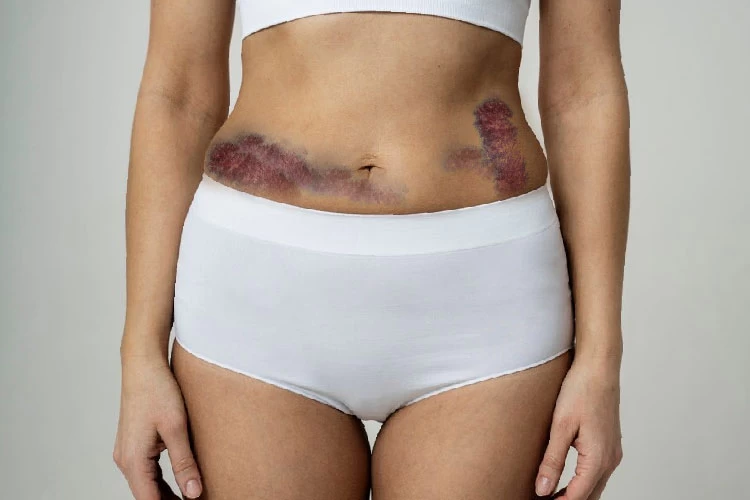Liposuction, an invasive body fat reduction treatment and popular cosmetic procedure, is a cosmetic surgery treatment, but many wonder about the bruising timeline afterward. Understanding what to expect from informational consultation can ease anxiety, help with recovery from surgical side effects, and assist how surgical bruising heal after liposuction procedures. Bruising is normal, and its duration varies from person to person. Typically, it peaks within the first week according to recovery guidelines and gradually fades over the following weeks after liposuctionwait.
Knowing the stages of healing, especially after liposuctionwait, can guide you through this process. You’ll learn how to manage discomfort and when to consult your doctor. Awareness of the bruising timeline and liposuctionwait will set realistic expectations for your journey. This information is crucial for anyone considering liposuction or currently recovering from liposuctionwait.
Understanding Liposuction Bruising
Commonality of Bruising
Bruising is a common side effect of undergoing liposuction. Most patients experience some level of bruising after the lipo procedure. This occurs because the lipo surgery involves making small incisions in the skin. During this process, blood vessels can be disrupted. The disruption leads to lipo blood leaking into surrounding tissues, resulting in visible bruises.
The severity and extent of bruising from lipo can vary from person to person. Factors such as individual healing abilities and the specific techniques used by the liposuction surgeon play a role. Generally, larger areas treated with liposuction may show more bruising.
How Bruising Occurs
Bruising happens during the liposuction procedure due to trauma to blood vessels. The lipo suctioning action disrupts these vessels, causing them to rupture. Blood escapes into the tissue, leading to discoloration. This process is similar to what happens when someone hits their arm or leg.
The type of liposuction method used can also influence bruising levels. Traditional liposuction tends to cause more bruising than newer methods like tumescent lipo. Tumescent techniques use a saline solution that minimizes bleeding, which can lead to less bruising overall.
Appearance and Color Changes
Initially, bruises appear reddish or purplish after the procedure. Over time, they change color as they heal. Within a few days, bruises typically turn blue or dark purple. This change indicates that the body is breaking down the blood that leaked into the tissue.
As healing progresses, bruises will shift to greenish or yellow hues before fading completely. The entire process usually takes about two weeks but can vary depending on individual recovery rates. Some people may notice lingering discoloration for several weeks.
Tips for Good Recovery
To promote good liposuction recovery, patients should follow specific care instructions from their surgeon. Here are some helpful tips:
-
Rest: Allow your body time to heal.
-
Ice Packs: Apply ice packs to reduce swelling and minimize bruising.
-
Compression Garments: Wear recommended compression garments to support healing.
-
Hydration: Stay hydrated to aid recovery.
-
Avoid Blood Thinners: Refrain from taking aspirin or other blood thinners unless directed by your doctor.
Immediate Post-Surgery Effects
Swelling and Bruising
Significant swelling and bruising appear right after liposuction. This is a common surgical side effect. Patients often notice these changes within the first few days. The bruising can vary in color, from dark purple to yellowish-green as it heals.
Mild discomfort typically accompanies the swelling. This discomfort varies from person to person. Some may feel more pain than others. It is important to monitor these symptoms closely.
Pain Management
Pain management plays a key role in recovery. Doctors often prescribe painkillers to help alleviate discomfort. Over-the-counter medications may also be effective for some patients. Following operative care instructions is crucial for minimizing pain.
Compression garments are essential during this time. They help reduce swelling and support the healing process. Wearing them as directed can lead to better results. These garments should fit snugly but not too tight, allowing for comfort while promoting recovery.
Movement Recommendations
Limited movement is advised in the immediate aftermath of surgery. Short, slow walks can improve circulation without straining the body. Patients should avoid strenuous activities or heavy lifting for several weeks.
Following operative guidelines ensures a smoother recovery. Staying active helps prevent complications like blood clots. However, listening to your body is necessary during this period.
Detailed Recovery Guidelines
Detailed recovery guidelines provide crucial information for patients post-surgery. Keeping track of any unusual symptoms is vital. If swelling worsens or pain increases significantly, contact your doctor immediately.
Patients should adhere strictly to their follow-up appointments. These visits allow doctors to assess healing progress and address concerns. Clear communication with healthcare providers leads to better recovery outcomes.
Decisions on Care
Decisions about postoperative care impact overall results. Choosing to follow medical advice regarding rest, medication, and activity level is essential. Each choice affects healing time and comfort levels.
Understanding the timeline for bruising and swelling aids in setting realistic expectations. Recovery takes time, but patience pays off in the long run.
First Week After Surgery
Bruising Timeline
During the first week after surgery, patients will notice changes in their bruising. Initially, bruises may appear dark purple or blue. This is normal and part of the body’s healing process. Over the week, the color will shift to green and yellow as it fades. By the end of seven days, most bruising should start to lessen significantly.
Compression Garments
Compression garments play a crucial role in recovery. They help manage swelling and support the surgical area. Patients must wear these garments as instructed by their surgeon. Wearing them consistently aids in reducing discomfort and promoting healing. The garments apply gentle pressure, which helps keep fluid from accumulating. This can lead to a smoother recovery experience.

Monitoring Recovery
Monitoring for complications is essential during this period. Patients should watch for any unusual symptoms. Signs like excessive swelling, increased pain, or fever could indicate issues. It’s important to contact a healthcare provider if these arise. Keeping follow-up appointments is also critical. These visits allow doctors to assess healing progress and address any concerns.
Activity Levels
Patients should limit their activity levels during this time. Light walking is encouraged to promote circulation but avoid strenuous exercise. Following the surgeon’s instructions regarding physical activity is vital for a safe recovery. Gradually increasing activity can help regain strength without risking complications.
Pain Management
Pain management remains a focus in the first week post-surgery. Surgeons often prescribe medications to help control discomfort. Patients should take these as directed to ensure effective pain relief. If pain worsens or becomes unbearable, contacting the healthcare provider is essential.
Emotional Well-being
Emotional well-being can fluctuate after surgery. Many patients experience a range of emotions during recovery. Feeling anxious or frustrated is common as the body heals. Support from friends, family, or counseling can provide comfort during this time.
Two to Four Weeks After Surgery
Healing Process
The healing process continues during this period. Incisions start to heal, leading to less discomfort. Most patients notice a significant reduction in pain by the end of the second week. This is a positive sign that the body is recovering well.
Bruising may still be visible but begins to fade. It can take several days for bruises to improve significantly. Patients often feel more comfortable as time passes. The skin surrounding the treated areas may also become less sensitive.
Swelling and Bruising
Mild swelling usually persists during this phase. It can vary from person to person. Some may experience more swelling than others. Typically, this swelling starts to decrease around the third week post-surgery.
Bruising may linger but improves gradually. By the end of four weeks, most bruises should show noticeable improvement. This timeline varies based on individual healing rates and overall health.
Resuming Activities
Patients often feel ready to return to light activities by the third or fourth week. Light exercise can help promote blood flow and aid recovery. Activities like walking or gentle stretching are usually safe at this stage.
Moderate exercise may also be possible after four weeks, depending on individual comfort levels. However, it’s crucial to listen to your body and avoid pushing limits too soon. Always consult with a healthcare provider before resuming any strenuous activities.
This period marks a transition towards normalcy for many individuals. They begin to see improvements in their appearance and overall well-being.
Four to Six Weeks After Surgery
Recovery Milestones
Patients often notice significant changes four to six weeks after their fat removal procedure. By this time, most bruising will have faded considerably. The skin may still feel sensitive, but the discomfort usually decreases. Many patients begin to feel more like themselves again.
During this period, individuals can return to normal exercise routines. Light activities such as walking and stretching are encouraged. However, high-impact workouts should be avoided until cleared by the cosmetic surgery expert. Each patient’s recovery timeline can vary based on age and overall health.
Compression Garments
Compression garments play a crucial role in the healing process. Patients typically wear these garments for about four weeks after surgery. At this point, many surgeons recommend discontinuing their use. This step helps the body adjust naturally without additional support.
e patients may still choose to wear them for comfort. It’s essential to follow the recovery guidelines provided by the surgeon during consultations. Proper care aids in achieving the best possible results.
Visibility of Results
The visibility of liposuction results becomes more apparent around this time. Swelling continues to subside, revealing a more contoured appearance. However, full results may take up to three months to show completely.
Patients should keep realistic expectations during this period. Factors such as individual healing rates and lifestyle choices affect how quickly results appear. Staying hydrated and maintaining a balanced diet promotes faster recovery.
Emotional Impact
The emotional aspect of recovery also plays a role during this phase. Many patients experience a boost in self-esteem as they see changes in their bodies. This newfound confidence can enhance motivation for maintaining an active lifestyle.
It is crucial for patients to communicate with their cosmetic surgery expert about any concerns or unexpected changes. Support from friends and family can also help ease anxiety during recovery.
Follow-Up Care
Regular follow-up appointments with the surgeon are vital during this time. These visits allow for monitoring progress and addressing any complications that may arise. Surgeons can provide personalized advice based on each patient’s unique situation.
Being informed about the recovery timeline helps manage expectations effectively. Understanding what to expect enhances satisfaction with the cosmetic procedure.
Normal Healing Process
Recovery Variability
Recovery times vary significantly among individuals. Factors include age, overall health, and the extent of the liposuction procedure. Younger patients often heal faster than older ones. Those in good health typically experience a smoother recovery. The areas treated can influence healing time. For instance, larger treatment areas may take longer to recover compared to smaller ones.
Each person has a unique healing timeline. Some may notice bruising fading within a week, while others might see it last up to several weeks. Pain levels also differ; some individuals report minimal discomfort, while others may require pain management for several days. Understanding these differences helps set realistic expectations.
Returning to Work
Returning to work generally occurs within one to two weeks after surgery. Many patients feel ready to resume light office work by the end of the first week. However, those with physically demanding jobs might need more time off. It is crucial to listen to your body during this period.
Normal activities can usually resume between two to four weeks post-surgery. Light activities like walking are encouraged early on, as they promote circulation and aid recovery. Strenuous exercise should be avoided until cleared by a doctor, typically around six weeks after surgery.
Importance of Post-Operative Care
Following post-operative care instructions is vital for optimal recovery. Surgeons provide specific guidelines tailored to each patient’s needs. These instructions often include wearing compression garments and managing swelling.
Proper care minimizes complications and promotes faster healing. Patients should attend follow-up appointments to monitor their progress. These visits allow doctors to assess bruising and swelling levels, ensuring everything is on track.
Patients must also maintain a healthy diet and stay hydrated during recovery. Nutrients support the body’s natural healing processes. Avoiding smoking and alcohol is equally important as these can hinder recovery.
General recovery advice emphasizes patience and self-care. Rushing back into regular activities can lead to setbacks or complications. Listening to your body and giving it time to heal is essential for long-term results.
Factors Influencing Bruising Severity
Age
Age plays a crucial role in bruising severity after liposuction. Younger individuals often heal faster than older patients. As people age, their skin becomes thinner and loses elasticity. This change makes older adults more prone to bruising. Circulation can weaken with age. Poor blood flow can prolong the healing process and increase visible bruising.
Health Status
A patient’s overall health significantly impacts recovery. Those with underlying health conditions may experience more severe bruising. Conditions like diabetes or blood clotting disorders can hinder healing. Medications that affect blood circulation, such as anticoagulants, also contribute to increased bruising. Maintaining good health before surgery can enhance recovery.
Skin Type
Skin type is another factor that influences bruising severity. People with fair skin may notice bruises more easily than those with darker skin tones. The contrast between the bruise and skin color makes it more visible. Skin texture and thickness can vary among individuals. Thinner skin is more susceptible to damage during the procedure, leading to greater bruising.
Treated Area
The area treated during liposuction affects bruising levels as well. Some regions of the body are more prone to bruising due to their vascularity. For example, areas with dense blood vessels, like thighs or abdomen, may bruise more than others. The amount of fat removed also matters. Larger volumes of fat extraction can lead to increased trauma to surrounding tissues, resulting in more significant bruising.
Surgical Technique
The surgical technique used during liposuction directly affects bruising outcomes. Surgeons who utilize gentler techniques may minimize tissue trauma. Techniques such as tumescent liposuction involve injecting fluid into the area before fat removal. This method helps reduce bleeding and swelling, leading to less bruising overall.
Surgeon’s Expertise
The skill and experience of the surgeon play a vital role in recovery as well. A qualified surgeon understands how to navigate tissues carefully to minimize damage. Their expertise can lead to better results and fewer complications. Patients should always research and choose a board-certified surgeon for their procedure.
Tips to Minimize Bruising
Avoid Medications
Patients should avoid blood-thinning medications before surgery. These can increase the risk of surgical bruising. Common blood thinners include aspirin and ibuprofen. Supplements like fish oil and vitamin E also fall into this category. Stopping these at least one week prior to the procedure may help reduce bruising.
Use Supplements
Consider using arnica or bromelain supplements after surgery. Arnica is known for its ability to reduce swelling and bruising. It is often applied topically as a cream or taken orally. Bromelain, derived from pineapples, also helps with inflammation. Both options can support healing and speed up recovery.
Stay Hydrated
Hydration plays a crucial role in recovery. Drinking plenty of water helps maintain skin elasticity. Well-hydrated skin can recover faster from any trauma caused during fat reduction treatment. Aim for at least eight glasses of water daily, especially after surgery.
Maintain Healthy Diet
Eating a balanced diet supports the healing process. Foods rich in vitamins C and K are particularly beneficial. Vitamin C aids in collagen production, which helps repair tissues. Foods like citrus fruits, strawberries, and bell peppers are excellent sources.
Vitamin K helps with blood clotting and reduces bruising. Leafy greens, broccoli, and Brussels sprouts are great options to include in meals. Incorporating these foods can enhance overall recovery.
Rest and Recovery
Rest is essential after any surgical procedure. Giving your body time to heal reduces stress on the affected areas. Sleep allows the body to repair itself effectively. Aim for at least seven to eight hours of sleep each night.
Minimizing physical activity during the early recovery phase is important too. Strenuous activities can lead to increased swelling and bruising. Follow your surgeon’s advice regarding when to resume normal activities.
Follow Post-Op Instructions
Following post-operative care instructions is crucial for minimizing bruising. Surgeons provide specific guidelines tailored to each patient’s needs. Adhering to these recommendations can significantly impact recovery time.
If any concerns arise during recovery, contact your healthcare provider immediately. They can offer guidance if unusual bruising occurs or if pain increases unexpectedly.
Closing Thoughts
Understanding the liposuction bruising timeline is crucial for your recovery journey. You’ve learned about the healing stages, what to expect in the weeks following surgery, and how to manage bruising effectively. Remember, everyone heals differently, but knowing the factors that can influence bruising severity helps you prepare better.
Frequently Asked Questions
What is the typical bruising timeline after liposuction?
Bruising usually begins within the first 24 hours post-surgery, peaks around days 3 to 5, and gradually fades over the next few weeks.
How long does bruising last after liposuction?
Most bruises resolve within 2 to 6 weeks. However, individual healing rates may vary based on personal factors.
Is bruising normal after liposuction?
Yes, bruising is a common side effect of liposuction. It indicates your body’s natural healing response.
Can I speed up the healing process for bruising?
While you can’t eliminate bruising instantly, staying hydrated, applying cold compresses, and following your surgeon’s aftercare instructions may help.
Are there any risks associated with excessive bruising?
Excessive bruising can indicate complications. If you notice unusual swelling or pain, contact your healthcare provider immediately.
Do certain factors affect the severity of bruising?
Yes, factors like skin type, age, surgical technique, and individual health conditions can influence how much bruising occurs.
What are some tips to minimize bruising after liposuction?
To minimize bruising, avoid blood thinners like aspirin pre-surgery, follow post-op care guidelines, and consider wearing compression garments as advised by your surgeon.





